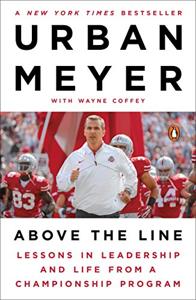
Want to learn the ideas in Above the Line better than ever? Read the world’s #1 book summary of Above the Line by Urban Meyer, Wayne Coffey here.
Read a brief 1-Page Summary or watch video summaries curated by our expert team. Note: this book guide is not affiliated with or endorsed by the publisher or author, and we always encourage you to purchase and read the full book.
Video Summaries of Above the Line
We’ve scoured the Internet for the very best videos on Above the Line, from high-quality videos summaries to interviews or commentary by Urban Meyer, Wayne Coffey.
1-Page Summary of Above the Line
Don’t Take Culture for Granted
Culture forms naturally within groups of people without deliberate action on anyone’s part. It is important to plan for culture, just as you would any other strategy. Culture is the process that explains why people do things in an organization and how they interact with each other. A powerful culture can compel employees to surrender their self-interests to the collective mission or purpose of the organization.
Managers who want to change their culture need to realize that it’s not a static concept. Culture is complex, ever-changing, and has many aspects. Employees have varying perspectives on your organization’s culture, and they may accept or reject the changes you make based on those perceptions. For example, if employees think that your culture goes against the reasons why they do their jobs, then they’ll be more likely to resist it.
Culture Trumps Strategy
“Culture is what turns a group of people into an organization.” If you create a culture that will benefit your company, it can be very helpful. However, if the culture is not good for your company, it can be detrimental. Your strategy should come second to your culture. Even though you might have a perfect strategy, if it does not align with your culture then it won’t work out well for you in the long run.
In some organizations, culture may not matter much because the organization is structured with a clear hierarchy and people are expected to follow orders without question. However, in most modern organizations, it’s important for leaders to define their company’s culture and strategy so that employees know how they’re expected to act and what the purpose of their work is. The three main strategies that companies can use when competing against other companies are price, service or product quality. If you want your company to lead its market, you need to choose only one of these strategies as your primary focus while making sure that every employee knows about it.
Use culturing to articulate your values and align them with your dominant strategy. Values define culture, so choose carefully. The “128 known human values” fall into three groups – control, relations, and development. If you’re product oriented, most of the values should stem from the development group; if you’re customer service focused, choose from the relations category; if price is your main focus then use the control category as a guideline for choosing your company’s values.
Rank your values in order of importance. If two of them contradict each other, you’ll need to know which is more important and everyone else needs to know as well.
Organizational values should align with employees’ personal values or, at the very least, not conflict with them. If there is a major disconnect between employee and organizational values, then no matter how great your culture is or what your strategy is, you will not be successful.
“Below-the-Line Cultures”
Below-the-line cultures are less effective. They suffer from higher turnover rates, lower effort and fewer ideas, which in turn leads to lower levels of customer care. This creates a cycle that increases costs and lost business for the company. Employees feel threatened by their leaders or co-workers, compete with each other instead of working together as a team, have no real purpose for doing what they do, don’t share knowledge with others and feel disconnected from each other and from their customers. Rumors run rampant while people hold on to valuable information so that it can be used against them later. As people reach the limit of how much they can tolerate such an environment before leaving the firm altogether, attrition accelerates until there is no one left who wants to work there anymore.





